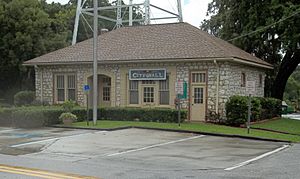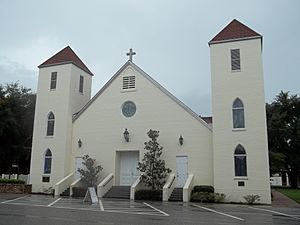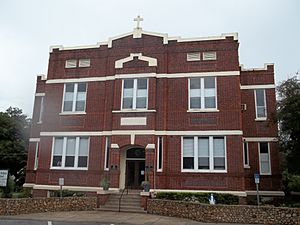San Antonio, Florida facts for kids
Quick facts for kids
San Antonio, Florida
|
|
|---|---|
| City of San Antonio | |

San Antonio City Hall (built 1939)
|
|
| Nickname(s):
San Ann, San An'
|
|
| Motto(s):
"Gem of the Highlands"
|
|

Location in Pasco County and the state of Florida
|
|
| Country | |
| State | |
| County | Pasco |
| Settled (San Antonio de Padua) |
February 15, 1882 |
| Incorporated (Town of San Antonio) | August 7, 1891 |
| Incorporated (City of Lake Jovita) |
June 2, 1926 |
| Incorporated (City of San Antonio) |
May 23, 1931 |
| Government | |
| • Type | Mayor-Commission fused |
| Area | |
| • Total | 1.36 sq mi (3.52 km2) |
| • Land | 1.36 sq mi (3.52 km2) |
| • Water | 0.00 sq mi (0.00 km2) |
| Elevation | 167ft/469ft ft (51/201 m) |
| Population
(2020)
|
|
| • Total | 1,297 |
| • Density | 954.38/sq mi (368.44/km2) |
| Time zone | UTC-5 (Eastern (EST)) |
| • Summer (DST) | UTC-4 (EDT) |
| ZIP code |
33576
|
| Area code(s) | 352 |
| FIPS code | 12-63375 |
| GNIS feature ID | 0290470 |
San Antonio, or unofficially "San Ann" or "San An" as the locals call it, is a city in Pasco County, Florida, United States. It is a suburban city included in the Tampa-St. Petersburg-Clearwater, Florida Metropolitan Statistical Area, much more commonly known as the Tampa Bay Area. It lies within Florida's 12th congressional district. The population was 1,297 at the 2020 census.
It was established as a Catholic colony by Judge Edmund F. Dunne. The city derives its name from Saint Anthony of Padua. Saint Leo University is located nearby.
Contents
History
San Antonio was founded (in name only) in 1881 by Edmund F. Dunne who previously had been chief justice of the Arizona territory. Dunne was a legal counsel involved in the Disston Land Purchase, and as his commission, received 100,000 choice acres (400 km2) of land out of the 4,000,000 acre (16,000 km²) purchase. The following year on February 15, while surveying the Disston Purchase with his cousin, Captain Hugh Dunne, Judge Dunne selected the city's location and began settling it. He established the city as the center of a Catholic colony in Florida. Dunne planned several other villages for the surrounding area including Saint Joseph, Saint Thomas, Villa Maria, Carmel and San Felipe, but only the rural community of Saint Joseph survives today. In 1889 the Benedictines established the monastery of St. Leo and St. Leo College on Dunne's former homestead and farm land, later incorporating the area as part of a separate town, St. Leo, Florida. At about the same time, five Benedictine sisters established Holy Name Convent in the center of San Antonio. The nuns had come to teach at two local schools (St. Anthony School and St. Joseph School), as well as to establish Holy Name Academy. The sisters had the convent and the academy physically moved by oxen to a 40-acre parcel in St. Leo overlooking the southwestern shore of Lake Jovita in 1911. The nuns remained at St. Anthony School until the end of the 2009-10 academic year. At the time of its founding San Antonio was located in the southern third of Hernando County, as Pasco County was not created until 1887. The Orange Belt Railway first began service to San Antonio in November 1887. For a short time in the 1920s San Antonio officially changed its name to the town of Lake Jovita, only to revert before the end of the decade.
Geography
San Antonio is located at 28°20′12″N 82°16′30″W / 28.33667°N 82.27500°W (28.336649, −82.275011).
According to the United States Census Bureau, the village has a total area of 1.2 square miles (3.1 km2), all land.
Climate
The climate in this area is characterized by hot, humid summers and generally mild winters. According to the Köppen climate classification, the City of San Antonio has a humid subtropical climate zone (Cfa).
Demographics
| Historical population | |||
|---|---|---|---|
| Census | Pop. | %± | |
| 1910 | 131 | — | |
| 1920 | 262 | 100.0% | |
| 1930 | 322 | 22.9% | |
| 1940 | 267 | −17.1% | |
| 1950 | 286 | 7.1% | |
| 1960 | 479 | 67.5% | |
| 1970 | 473 | −1.3% | |
| 1980 | 529 | 11.8% | |
| 1990 | 776 | 46.7% | |
| 2000 | 655 | −15.6% | |
| 2010 | 1,138 | 73.7% | |
| 2020 | 1,297 | 14.0% | |
| U.S. Decennial Census | |||
2010 and 2020 census
| Race | Pop 2010 | Pop 2020 | % 2010 | % 2020 |
|---|---|---|---|---|
| White (NH) | 1,043 | 994 | 91.65% | 76.64% |
| Black or African American (NH) | 12 | 32 | 1.05% | 2.47% |
| Native American or Alaska Native (NH) | 0 | 11 | 0.00% | 0.85% |
| Asian (NH) | 4 | 17 | 0.35% | 1.31% |
| Pacific Islander or Native Hawaiian (NH) | 0 | 0 | 0.00% | 0.00% |
| Some other race (NH) | 3 | 3 | 0.26% | 0.23% |
| Two or more races/Multiracial (NH) | 7 | 54 | 0.62% | 4.16% |
| Hispanic or Latino (any race) | 69 | 186 | 6.06% | 14.34% |
| Total | 1,138 | 1,297 |
As of the 2020 United States census, there were 1,297 people, 447 households, and 342 families residing in the city.
As of the 2010 United States census, there were 1,138 people, 414 households, and 302 families residing in the city.
Education
San Antonio is home to two schools. Saint Anthony Catholic School (grades PreK–8) traces its roots to the Fall of 1883 when local widow Cecilia Morse began teaching colony children in her home. By April 1884 it was officially established as a Catholic school and is by far the oldest school of any kind in Pasco County. In fact it actually predates the county by several years. San Antonio Elementary (grades K–5) was founded 98 years later in 1981 and though its campus lies entirely within San Antonio's city limits, its mailing address is actually Dade City, Florida. Holy Name Academy (grades 1–12) was established in 1889 as an "all-girls" boarding school by the Benedictine Sisters of Florida, but moved to the neighboring town of St. Leo in 1911.
Notable people
- Chris Arnade, former Wall Street trader and documentarian, grew up in San Antonio
See also
 In Spanish: San Antonio (Florida) para niños
In Spanish: San Antonio (Florida) para niños



